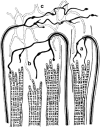How does the structure of extraocular muscles and their nerves affect their function?
- PMID: 25397785
- PMCID: PMC4330282
- DOI: 10.1038/eye.2014.269
How does the structure of extraocular muscles and their nerves affect their function?
Abstract
The sensory and motor control of human extraocular muscles (EOMs) have been subjected to considerable speculation in ophthalmic literature, often related to infranuclear structures such as the unique complement of muscle fibres and their associated sensory organs. The intrafusal fibres do not resemble their somatic counterparts and their peculiar morphology has raised questions about their proprioceptive capacity. No Golgi tendon organs have so far been observed and the myotendinous nerve endings, previously assumed to convey sensory information, have recently been argued to merely represent constituents of the efferent innervation serving the multiply innervated muscles fibres. These observations raise questions about the overall capacity to monitor the activity created by the generous efferent nerve supply observed in these muscles. Furthermore, the argued independent activity of muscular layers and compartments suggest that the required feedback must be highly structured and more specific than previously assumed. Yet, uncertainty about the source of such information remains. The purpose of this paper is to provide a short review of neuromuscular properties of human extraocular muscles. Their functional implications and the most reputable sources of proprioception will also be discussed. The promoted views are based on pertinent literature and previous research undertaken by the authors.
Figures






Similar articles
-
Palisade endings and proprioception in extraocular muscles: a comparison with skeletal muscles.Biol Cybern. 2012 Dec;106(11-12):643-55. doi: 10.1007/s00422-012-0519-1. Epub 2012 Oct 10. Biol Cybern. 2012. PMID: 23053430 Review.
-
Myotendinous nerve endings in human infant and adult extraocular muscles.Anat Rec. 2000 Oct 1;260(2):132-40. doi: 10.1002/1097-0185(20001001)260:2<132::AID-AR30>3.0.CO;2-H. Anat Rec. 2000. PMID: 10993950
-
Proprioception in the extraocular muscles of mammals and man.Strabismus. 2006 Jun;14(2):101-6. doi: 10.1080/09273970600701192. Strabismus. 2006. PMID: 16760116
-
Motor and sensory innervation of extraocular eye muscles.Ann N Y Acad Sci. 2003 Oct;1004:40-9. doi: 10.1111/j.1749-6632.2003.tb00240.x. Ann N Y Acad Sci. 2003. PMID: 14662446 Review.
-
Innervated myotendinous cylinders in human extraocular muscles.Invest Ophthalmol Vis Sci. 2000 Aug;41(9):2422-31. Invest Ophthalmol Vis Sci. 2000. PMID: 10937549
Cited by
-
A Subset of Palisade Endings Only in the Medial and Inferior Rectus Muscle in Monkey Contain Calretinin.Invest Ophthalmol Vis Sci. 2018 Jun 1;59(7):2944-2954. doi: 10.1167/iovs.18-24322. Invest Ophthalmol Vis Sci. 2018. PMID: 30025142 Free PMC article.
-
Accuracy of Repetitive Ocular Vestibular-Evoked Myogenic Potentials to Diagnose Myasthenia Gravis in Patients With Ptosis or Diplopia.Neurology. 2024 May;102(10):e209395. doi: 10.1212/WNL.0000000000209395. Epub 2024 Apr 26. Neurology. 2024. PMID: 38669629 Free PMC article. Clinical Trial.
-
Mass Spectrometric Profiling of Extraocular Muscle and Proteomic Adaptations in the mdx-4cv Model of Duchenne Muscular Dystrophy.Life (Basel). 2021 Jun 22;11(7):595. doi: 10.3390/life11070595. Life (Basel). 2021. PMID: 34206383 Free PMC article.
-
One-to-one innervation of vocal muscles allows precise control of birdsong.Curr Biol. 2021 Jul 26;31(14):3115-3124.e5. doi: 10.1016/j.cub.2021.05.008. Epub 2021 Jun 4. Curr Biol. 2021. PMID: 34089645 Free PMC article.
-
Normal Anatomy and Anomalies of the Rectus Extraocular Muscles in Human: A Review of the Recent Data and Findings.Biomed Res Int. 2019 Dec 28;2019:8909162. doi: 10.1155/2019/8909162. eCollection 2019. Biomed Res Int. 2019. PMID: 31976329 Free PMC article. Review.
References
-
- Lienbacher K, Horn AK. Palisade endings and proprioception in extraocular muscles: a comparison with skeletal muscles. Biol Cybern. 2012;106:643–655. - PubMed
-
- Haugen IBK, Bruenech JR. The potential role of sensory receptors in ocular movements. Acta Ophthalmol Scand. 2007;85 (s240
-
- Ruskell GL. Extraocular muscle proprioceptors and proprioception. Prog Retin Eye Res. 1999;18 (3:269–291. - PubMed
-
- Demer JL, Oh SY, Poukens V. Evidence for active control of rectus extraocular muscle pulleys. Invest Ophthalmol Vis Sci. 2000;41 (6:1280–1290. - PubMed
Publication types
MeSH terms
LinkOut - more resources
Full Text Sources
Other Literature Sources

